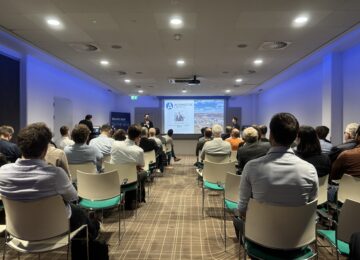Interview with Martijn Rijk and Sander Bubberman of DuurzaamInvesteren
Energy Storage NL is holding an interview series with its participants. As part of "storage financing month," a campaign series to draw more attention to energy storage financing, this time the following are speaking: Martijn Rijk, CCO of DuurzaamInvesteren, and Sander Bubberman, currently Investment Manager of Meewind. In this conversation, Martijn and Sander talk about DuurzaamInvesteren's role within the storage sector, the dynamic developments in the financial and renewable energy markets, and offer advice on how companies can keep their plans feasible and flexible in an increasingly complex energy landscape.
Could you tell us briefly about SustainableInvest's role in the energy storage sector?
SustainableInvest plays an important role in the energy storage sector by providing financing opportunities where banks are potentially reluctant. Banks often require a comprehensive track record and remain cautious in their financing choices. We target companies that already have some form of revenue and are promising, but may not meet the stringent criteria of traditional financiers. We do this by attracting individuals and companies who want to make sustainable investments. This is how we have raised some 380 million euros over the past decade.
We are not limited to the Netherlands; we can also help companies inside and outside the EU with their financing request. In the energy storage sector, we offer financing for growth and innovation. Although we do not always fill the total financing needs needed, we can step in as both senior and junior investors. Our role is also to help companies scale up to other forms of financing, such as banks or larger funds, so they can continue to grow and we can refocus on new, promising projects.
How do you get in touch with these types of projects? How do you find companies or projects that you would like to fund?
We come into contact with projects through various channels. Our membership in Energy Storage NL plays a role in this. We find it important to be close to the target group. In addition, we actively work on our visibility by participating in events to promote our platform. Our team of business development and analysts keeps a sharp eye on the market and maintains active contact with potential partners.
In addition, our reputation helps tremendously. When a project on our platform raises 1.5 million euros within 24 hours, it creates word-of-mouth advertising. New companies approach us with proposals, even though we unfortunately have to reject many of them due to a mismatch or uncertainties in the project we like to engage in conversation with the entrepreneur every time. If rejected, we often try to put these companies in touch with parties in our network that are a better fit for them.
Our selection criteria are fairly strict. Projects must be well mapped out, with clear EPC contracts, signed off-take contracts, and all necessary permits must also be in order. The revenue model must be solid, and we analyze market simulations to assess how an energy storage system would have performed in the past.
We prefer companies with good knowledge of EMS systems or operate them ourselves because they are better able to understand and respond to market conditions and algorithms. Companies that only operate battery systems tend to be less attractive to us. Our goal is to work with clients who have an understanding of their own product and can achieve growth based on well-grounded models.
How do you relate to other private finance parties?
We distinguish ourselves by our focus on projects that fit within clean energy, with an accessible entry threshold starting at EUR 500,000. Other private financiers often work with larger amounts through fund structures, which is a different market segment.
The funding landscape consists of several steps: regional development companies often take on more risk and work with young companies. Next comes crowdfunding, where companies with a small track record can already show potential. After that, companies often move on to larger funds and banks. We see it as our role to facilitate that crucial intermediate step.
What types of energy storage projects does SustainableInvest support?
Currently, we mainly fund battery storage projects. These are systems linked to solar and wind farms or mobile batteries for construction sites, for example. Hydrogen and thermal storage typically have higher costs and complex business cases that are currently difficult to make ends meet without subsidies.
However, we have funded alternative technologies, such as flywheel technology. In the future, we would also like to look at larger hubs and collaborations between parties in the energy storage and distribution landscape. Looking across the board at financing and enabling different projects with many different stakeholders can be difficult. We as DuurzaamInvesteren see opportunities to partner with different parties in those kinds of projects as well.
What is the average capacity of energy storage projects financed through your platform?
Average capacity varies. Temporary energy storage solutions are often around 300 kilowatts, while systems linked to solar or wind farms are usually between 1 and 5 megawatts. One recent project, Gridstabilizer, had a capacity of 5 megawatts and can be expanded to 15 megawatts. It is difficult to calculate an exact average value, but most systems fall within this capacity.
What is one project with a storage company that you are really proud of?
We are proud of several projects. GIGA Storage is a good example: we guided them from their first round of financing to a successful partial early repayment, after which larger parties such as InfraVia stepped in. eQip Energy is another proud project, because of their innovative technology with faster charging cycles and applications in peak areas such as ports.
The pride is not only in the projects themselves, but also in the connection we have with our investors and clients. Ultimately, it is the investors who decide which projects they believe in.
How do you see the current financial trends around storage?
The financial market for energy storage is evolving with a mix of gradual and more dynamic changes. Positive trends include a €400 million fund for storage at solar farms and a government fund for bi-directional charging for electric cars, which contributes to more efficient use of the energy grid. Hydrogen storage is gaining attention again, and subsidies for neighborhood batteries are making the energy landscape more manageable at the microscale, ultimately contributing to a more balanced system.
Regarding European imbalance rules, we see that they are still in their infancy. Although initial results have been positive, for example with less imbalance and normalized prices, there have also been stress reactions. In the short term, this has led to greater imbalance and higher prices. Nevertheless, we believe that in the long run these rules can contribute to more stable and predictable prices, which can be beneficial for project financeability.
Together, we believe these trends are leading to a more mature market, where subsidies and government support are a springboard to more self-sufficient and robust systems. It is a process that will take time, but current movements give confidence in a future with a more efficient and sustainable energy landscape.
How do your projects deal with the uncertainties and challenges surrounding future regulations in energy storage? And how does this affect your strategy and operational choices?
Future regulation around energy storage poses challenges due to unpredictability, especially in the Netherlands where political uncertainty and the double taxation system add complexity. This makes it harder to develop reliable business cases, while countries such as Belgium are more attractive due to a more stable regulatory environment and the absence of double taxation. This difference often makes projects there more calculable and thus more interesting to investors.
To minimize the impact of these uncertainties, we take a conservative approach. For example, we have increased our financial buffers to 25-35% and in some cases we place more risk with operators. Contracts such as TenneT's ATR85 are essential because they provide stability and certainty in the business case. By pledging these contracts, you thus minimize risk for private investors and increase the financeability of projects. The more certainty there is, the more comfortable investors can get in. Through its platform, DuurzaamInvesteren facilitates the possibility of raising finance.
In addition, issuers keep investors well informed through regular updates on performance and market changes. This reinforces their confidence and helps us better anticipate future developments. At the same time, we advocate for more regulatory predictability and stability, which is essential for investment, the energy transition, and the growth of sectors such as solar panels and home batteries.
Are there any projects where, in retrospect, you would have liked to do things differently? What lessons can be learned from them?
We learn from each project because every project is unique. Our established process, from entrepreneur interviews to investment committees to an information memorandum, provides structure. Yet we see that each project has specific challenges due to varying products, maturities, forms of financing, and business setups. This keeps us constantly learning and improving as an organization.
A key lesson is the importance of early contact. Entrepreneurs who engage in conversation early, as Refurb did, benefit. They discussed financing options before they even had customers, which facilitated their continued planning and agreements. Knocking on the door later can cause problems, such as unexpected fees or interest rate increases that make a product less profitable.
Our advice to entrepreneurs is therefore to come to the table early and adopt a cost-plus model. This way they have a better overview of the financial feasibility and profit margins remain intact, even in the event of unforeseen market or interest rate developments. As a result, projects can not only be executed more successfully, but also presented more effectively to customers and investors.
What motivated you to join Energy Storage NL?
Joining Energy Storage NL provides a platform to share knowledge and raise awareness. Membership is seen as a marketing channel and a way to promote alternative financing as a means to grow businesses. Personal contacts and previous collaborations also played a role in this choice.





